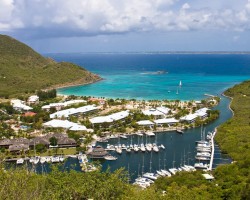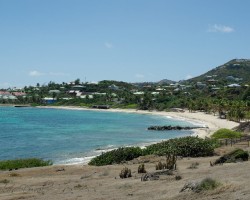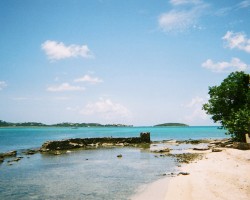Best time to go to Saint Martin for a perfect weather and where to go?
When is the best time to go to Saint Martin?
The best time to visit Saint-Martin is the dry season, which runs from December to March, as well as in June. However, a stay all year round is entirely possible. Indeed, if you wish to discover Saint-Martin and its peculiarities on both sides of the island, you may prefer to travel during the low season, mainly between July and November. During the rainy season, tourists are few and the island regains its authenticity. And as the weather remains decent, there is little chance that showers will disrupt your plans.
When is the best time to visit Saint-Martin for great weather but fewer crowds? December and February mark the peak tourist season on the island: visitors flock to spend the holidays in the sun or coincide their trip with the most significant cultural event of the year, which is the carnival. During these two months, prices soar, whether for flights or accommodations on site. The best compromise is to visit Saint-Martin in January, March, April, or even better in June! During this transitional month, the crowds are lower, rainfall is still low, and you can enjoy the sun and pleasant warmth.
Finally, here are some random tips for visiting Saint-Martin:
- The island is volcanic and mountainous. Its summit is Pic du Paradis, which rises to 424 meters above sea level. If you want to climb it, allow about 45 minutes for the hike. As the trail is steep, it is essential to wear good closed-toe shoes.
- If you want to engage in water sports, such as kitesurfing or windsurfing, head to the northeast of the island, in the districts of Baie Orientale and Oyster Pond, where the trade winds blow stronger than elsewhere.
- Conversely, if you prefer calm waters, it is better to opt for sheltered coves from the swell, such as Anse Marcel. Simpson Bay and Pinel Island Beach are also sheltered from the wind, perfect for lounging on the sand and swimming in pleasantly warm waters.
- For scuba diving or snorkeling, the islet Tintamarre, further offshore, is renowned.
- To change things up from the beach, you can also go kayaking in the mangrove.
Annual weather in Saint Martin
For information about the climate and the weather city by city in Saint Martin for a specific month, click on the corresponding line below:
| Month | Our opinion | View Details | |||
|---|---|---|---|---|---|
| January | 81°F | perfect weather* | |||
| February | 79°F | perfect weather* | |||
| March | 79°F | perfect weather | |||
| April | 81°F | good weather | |||
| May | 83°F | tolerable weather* | |||
| June | 83°F | good weather | |||
| July | 85°F | tolerable weather* | |||
| August | 85°F | tolerable weather | |||
| September | 85°F | tolerable weather | |||
| October | 85°F | tolerable weather | |||
| November | 83°F | tolerable weather | |||
| December | 81°F | good weather |
Best time to travel to Saint-Martin by cities
Climate and Weather in Saint Martin
Saint-Martin is a French overseas collectivity that occupies the northern part of the island of the same name, with the southern part being Sint Maarten, a constituent country of the Kingdom of the Netherlands within the Dutch Caribbean. The island is located in the Caribbean, south of Anguilla (these islands are so close that there is a ferry connection between Blowing Point and Marigot), north of Saint Kitts and Nevis, and east of the Virgin Islands. And to the west? The vastness of the Atlantic Ocean!
The climate of Saint-Martin is tropical savanna with a dry winter, featuring a dry season and a wet season. Rainfall is not abundant on the island, which is why there is more talk of a wet season rather than a rainy season. However, between June and December, Saint-Martin is susceptible to cyclones. Nevertheless, this phenomenon is rare compared to neighboring islands like Guadeloupe or Martinique. Temperatures remain almost constant throughout the year, with fairly high values that are still bearable thanks to the trade winds blowing from the east and northeast across the island. In fact, it is the east coast that bears the brunt of these winds and is nicknamed "the windward coast". Clouds remain condensed there due to the terrain, making it the wettest part of the island and resulting in lush vegetation. In contrast, the limestone plateau of Terres Basses in the west is more sheltered from rain, leading to much drier vegetation.

Climate during the rainy season
Spanning from May to November, with a significant lull in June, the rainy season still offers very decent weather conditions. The weather in Saint-Martin during this period is characterized by more frequent showers, but they are brief. Locals refer to these as "showers" that quickly give way to radiant sunshine.
The rainiest period extends from September to November, with a risk of rain for 11 to 13 days per month. The air is a bit more humid, but overall rainfall levels are moderate.
In terms of temperatures, expect averages around 28-29°C both in the air and in the water. At night, the mercury remains constant, with no significant drop, maybe just one degree lower.
Climate during the dry season
The weather in Saint-Martin is most pleasant during the dry season, from December to April. The island will welcome you warmly, quite literally! Temperatures are slightly lower than during the rainy season, but still quite warm. Expect between 26 and 27°C (81°F) during the day and night, with similar values in the water.
The humidity in the air is lower, making the atmosphere less stifling. However, the risk of a shower is not zero, especially in December and April.
Temperatures and rainfall in Saint Martin
On these 3 graphs, we present the evolution of temperatures of Saint-Martin and month-by-month rainfall for the cities of Marigot (Saint-Martin), anse-Marcel, baie-de-Lucas, baie-Nettlé and Colombier, as well as the month-by-month sea temperature for coastal cities.
Peak visitor numbers and tourist seasons in Saint Martin
Find out when Saint-Martin has its high tourist season (the period when the influx of tourists is highest) and off-peak tourist season using our data and figures.
Tourist seasons in Saint Martin
The months with low numbers of tourists are: April, May, June, July, August, September, October and November. The number of visitors to Saint-Martin is high in: January, February, March and December.
- Very low season in Saint Martin: May, June, September, October and November.
- Low season in Saint Martin: April, July and August.
- High season in Saint Martin: January.
- Peak season in Saint Martin: February, March and December.
Figure: Visitor index for Saint-Martin month by month
Average price for flights to Saint Martin
A return flight between New York City and Marigot (Saint-Martin) is generally cheaper if you go in january ($ 1419 on average): this is the best time for travellers on a tight budget. In contrast, you may end up paying $ 722 more for your airline ticket to Marigot (Saint-Martin) if you go in july.
Where to go in Saint Martin?
This table allows you to see the maximum temperature for each city and our opinion on the weather month by month (see colour legend below the table).
| Cities | jan. | feb. | mar. | apr. | may | jun. | jul. | aug. | sep. | oct. | nov. | dec. |
| Marigot (Saint-Martin) | 81°F | 79°F | 79°F | 81°F | 83°F | 83°F | 85°F | 85°F | 85°F | 85°F | 83°F | 81°F |
| anse-Marcel | 81°F | 79°F | 79°F | 81°F | 83°F | 83°F | 85°F | 85°F | 85°F | 85°F | 83°F | 81°F |
| baie-de-Lucas | 81°F | 79°F | 79°F | 81°F | 83°F | 83°F | 85°F | 85°F | 85°F | 85°F | 83°F | 81°F |
| baie-Nettlé | 81°F | 79°F | 79°F | 81°F | 83°F | 83°F | 85°F | 85°F | 85°F | 85°F | 83°F | 81°F |
| Colombier | 81°F | 79°F | 79°F | 81°F | 83°F | 83°F | 85°F | 85°F | 85°F | 85°F | 83°F | 81°F |
Legend:
perfect weather
good weather
tolerable weather
About Saint-Martin
What can I do in Saint Martin?
Beaches / swimming
Nature and countryside
Culture and heritage
Sports
Family travel
Crafts / shopping
Gastronomy
Nightlife
Is this weather information for Saint-Martin reliable?
Climate data for Saint-Martin has been gathered every day since January 2009. The analysis of these meteorological data for Saint-Martin allows us to determine the average for each month in Marigot (Saint-Martin), anse-Marcel, baie-de-Lucas, baie-Nettlé and Colombier.
So yes: this data is reliable except in cases of temporary climate disruption in the region.





